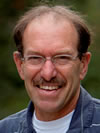 Tim Lowenstein |
2016 Laurence L. Sloss Award
Presented to Tim Lowenstein
Citation by Teresa Jordan
The selection of Tim K. Lowenstein as the 2016 recipient of the Laurence L. Sloss Award for Sedimentary Geology recognizes his superb record of extracting valuable historical information from chemical sediments. Tim completed his undergraduate degree at Colgate University, his Ph.D. at Johns Hopkins University, and worked for two years in the research lab of Conoco, Inc. He has been a faculty member at Binghamton University since 1985.
Tim uses field and laboratory studies to tease data on environmental conditions from minerals, and, in particular, the fluids and microbes trapped in fluid inclusions in those minerals. His work has implications from the scale of a single salt crystal up to the solar system. Major breakthroughs encompass terrestrial microbial analogues to Martian life, secular changes in Phanerozoic seawater composition, Eocene atmospheric CO2 content, the Messinian salt crisis, and Quaternary paleoclimate history of three continents. Simultaneously, Tim advanced the quality and utility of an array of research methods. He showed how to improve field study of modern evaporite depositional environments, to recognize paleohydrology proxies, to determine paleo-temperature, to use environmental scanning electron microscopy/X-ray dispersion to characterize fluid inclusions, and to isolate microbes in halite fluid inclusions for DNA characterization.
Tim makes evaporite rocks and minerals spill their secrets. Two topics are especially germane to the GSA sedimentary geology community. First, what could be more important to Phanerozoic sedimentary rocks than the water with which most sediments interacted on their way to becoming rocks? With colleagues, Tim has probed the changing major element chemistry of the world oceans, in works spanning Earth’s large-scale cycles. Second, Tim broke the code for an important class of ancient lake deposits, to tell the histories of paleo-hydrological change where there were no fossils and no organic matter to provide conventional climate proxies.
Among other service activities, Tim Lowenstein has served the research community generously as an associate editor of Geology, of Journal of Sedimentary Research, and of Geochimica et Cosmochimica Acta.
 2016 Laurence L. Sloss Award — Response by Tim Lowenstein
2016 Laurence L. Sloss Award — Response by Tim Lowenstein
My sincere thanks to the Award Committee of the Sedimentary Geology Division for the Laurence Sloss Award and to Teresa Jordan for her nomination and citation. It is a great honor to receive this award especially because I am a nontraditional sedimentary geologist. Study of chemical sediments and sedimentary rocks has blossomed in the last 30 years. We use mineral assemblages to calculate atmospheric CO2. We know from seawater trapped in fluid inclusions in halite that the chemistry of the oceans varied in the past, and those variations influenced the evolution of marine shell building organisms. We know deep freshwater lakes existed in closed basins now covered by saline pans. As my graduate school mentor at Johns Hopkins, Lawrie Hardie once said, chemical sediments carry much greater scientific weight than their volumetric abundance in the geologic record. Lawrie used elegantly simple ideas, such as chemical divides, to explain how natural waters in closed basins evolved into brines, and how the zonation of saline minerals and brines in Saline Valley could be explained by chemical principles. Back then, surprisingly, geochemical theories were ahead of our knowledge about what evaporites actually looked like, and their potential as paleoenvironmental and paleoclimatic indicators was largely untouched.
The 1990s brought new techniques for chemical analysis of fluid inclusions, pioneered by a team of geochemists at the University of Barcelona and at Binghamton by Mike Timofeeff. Now we could chemically analyze fossil waters in fluid inclusions and document the secular variations in the chemistry of ancient seawater first proposed by Ron Spencer and Lawrie Hardie. Fluid inclusions in saline minerals are also hosts for microbial life. The discovery of ancient microbial ecosystems trapped inside fluid inclusions in buried halite from Death Valley, Saline Valley, and Searles Lake, more than 1 million years old, along with DNA and living organisms, has been an astonishing surprise.
I thank many collaborators who have taught me so much including Bob Demicco, Joe Smoot, Lawrie Hardie, Ron Spencer, Terry Jordan, Linda Godfrey, Paul Baker, Sheri Fritz, Richard Ku, Shangde Luo, Robin Renaut, Bernie Owen, Kathy Benison, Alan Carroll, Stefano Lugli, Javier Garcia-Veigas, David Jenkins, Joe Graney, Jeff Pietras, Andy Cohen, Russell Vreeland, Matthew Parker, Koji Lum, and Juske Horita. I am grateful to Colgate professors Bruce Selleck, Rich April, and Jim McLelland for getting me started in geology. I acknowledge the 32 wonderful graduate students and postdocs I have had. Their work is at the core of everything I have accomplished. Finally, I thank my geology colleagues at Binghamton, and my wife Sally, for providing the freedom and time to follow my dreams.
